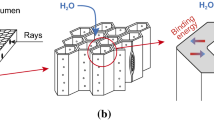Summary
Water in contact with wood surfaces is able to penetrate into the cellular structure by three routes: 1. As liquid water into cell lumena, by capillarity. — 2. As water vapour, by diffusion into cell lumena. — 3. As bound water, by diffusion within the cell wall.
Transport from cell lumena into adjacent cell walls occurs rapidly by diffusion. In Scots pine (Pinus sylvestris) sapwood, it is shown that transport over short distances occurs much more rapidly by capillarity than by either of the diffusion processes. Treatment of wood with resin/wax water repellent formulations greatly reduces the rate of water flow due to capillarity and hence significantly cuts down the rate of dimensional change of specimens exposed to wet conditions.
Swelling rates due to vapour phase and bound water diffusion were measured experimentally, and these data were used to predict the water sorption rates for specimens treated with a theoretically perfect water repellent, viz. that which excludes all liquid water.
It was found experimentally that specimens immersed in water, after treatment with resin/wax water repellents, swelled more rapidly than predicted by the above procedure. This more rapid swelling is probably due to a certain amount of liquid water flow made possible by displacement of the hydrophobic film from cell wall surfaces (preferential wetting). It is suggested that the use of hydrophobic agents bonded chemically to the cell wall may be necessary to attain optimum water repellent effectiveness.
Similar content being viewed by others
References
Banks, W. B. 1970a. A standard test to measure the effectiveness of water-repellent solutions. Timberlab Paper No. 40, Building Research Establishment, Princes Risborough Laboratory, Prices Risborough, Aylesbury, Buckinghamshire.
Banks, W. B. 1970b. Some factors affecting the permeability of Scots pine and Norway spruce. J. Inst. Wood Sci. 5 (1): 16–19.
Banks, W. B. 1971. The role of water-repellents in the protection of timber. Rec. Ann. Conv., Brit. Wood Pres. Ass., 129–147.
Borgin, K. 1968. The protection of wood against dimensional instability. Bosb Suid-Afr 9, 81–94.
Bramhall, G. 1970. The validity of Darcy's law in the axial penetration of wood. Ph. D. thesis, Syracuse University.
Kollmann, F. F. P., Côté, W. A. 1968. Principles of wood science and technology, Vol I. Solid Wood. Springer-Verlag, Berlin.
McGregor, R. R. 1954. Silicones and their uses. McGraw-Hill, London.
Moilliet, J. L. (ed.) 1963. Water-proofing and water repellency. Elsevier Pub. Co., Amsterdam.
Stamm, A. J. 1959. Bound water diffusion in the fiber direction. Forest Prod. J. 9 (1): 27–32.
Stamm, A. J. 1960a. Bound water diffusion in across-the-fiber directions. Forest Prod. J. 10 (10): 524–528.
Stamm, A. J. 1960b. Combined bound water and water vapour diffusion into Sitka spruce. Forest Prod. J. 10 (12): 644–648.
Stamm, A. J. 1964. Wood and cellulose science. Ronald Press, New York.
Tack, C. H. 1968. The moisture content of window joinery in service. Building 214 (6516): 135–136.
Tarkow, H., Stamm, A. J. 1960a. Diffusion through air-filled capillaries of softwoods—Part I: Carbon dioxide. Forest Prod. J. 10 (5): 247–250.
Tarkow, H., Stamm, A. J. 1960b. Diffusion through air-filled capillaries of softwoods—Part II: Water vapour. Forest Prod. J. 10 (6): 323–324.
Author information
Authors and Affiliations
Rights and permissions
About this article
Cite this article
Banks, W.B. Water uptake by scots pine sapwood, and its restriction by the use of water repellents. Wood Science and Technology 7, 271–284 (1973). https://doi.org/10.1007/BF00351073
Received:
Issue Date:
DOI: https://doi.org/10.1007/BF00351073




